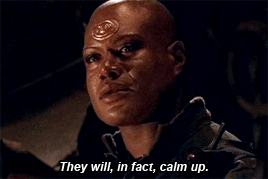Emotions are wise and on our side.
Where mindfulness has gone too far, and how to get it back on track.
At The Body Knows, we’re trading self-improvement for self-trust and rooting personal development in collective liberation. Subscribe to receive a post in your inbox every week. And give this post a ♥️ or 🔁 to help our message spread!
I spent years trying to be the rock at the bottom of the riverbed.
I sat dutifully on my makeshift meditation cushion (a pile of sweaters) and counted my breaths. Whenever I realized I had gotten lost in a thought loop, I would gently label it “thinking” and attempt to untangle myself from the mental chatter.
I understood the concept — my thoughts were twigs, leaves, and unlucky bumblebees floating through my consciousness. Instead of engaging with the content of each thought, I could just let it sail past. I could be the slick stone in the sand below, amidst but unmoved by the endless flow of ‘I should have’s and ‘what if’s and ‘the group chat ignored my message because’s.
Operative word: could.
Before I start having too much fun shitting on mindfulness, let me say that WE ALL NEED IT.
The fabric of society couldn’t exist without it.
Creating space between ourselves and our thoughts helps us do things like:
Refrain from saying out loud all the terrible things we think.
Not eat french fries and/or ice cream for every meal.
Exercise for more than 15 seconds at a time.
Not get arrested.
Self awareness and self control, baby.
But mindfulness on its own can teach us a dark lesson:
Any part of us that has instincts or urges that fall outside of “civilized conduct” (said in a posh British accent) are not to be trusted, and definitely not acted upon.
In other words, ignore the uncomfortable aspects of self, keep calm, and carry on.
(I’m not saying that this is what the teachers of mindfulness intend, but any good idea can be taken too far. Just look at *waves at society*.)
So there I was, an anxious, perfectionist, wannabe Buddhist who fell asleep in her pile of sweaters every time she tried to meditate for more than eight minutes. I was still struggling to find any sense of internal peace, and now was also berating myself for failing at even mindfulness.
I thought I was helping myself, but it felt like I was cramming myself into a smaller, tighter box. It wasn’t just enough to just be perfect on the outside, I had to be perfect on the inside too.
Until someone told me that my seething, disorganized, headless monster of internal chaos wasn’t the problem, but the symptom.
I didn’t need any more restraint. I needed release.

breathing break
Here’s my annual attempt at defining embodiment:
Embodiment (n): the state of allowing yourself to feel and express whatever is roiling within you — emotion, tension, energy, etc — without judgment or explanation.
Embodiment without mindfulness is like a toddler wailing, blissfully unconcerned if they have a good reason to be wailing or if they are waking up everyone on the flight. This is not what I’m recommending.
But I am saying we’ve gone too far to the other end of the spectrum and need to course correct.
The self-help contingent of the internet has taken the idea of civility and applied it to every aspect of our beings:
What we feel ought to be reasonable, and how we express even more so.
However, the human experience does not bend to the same rules.
Life hasn’t limited reasons to feel grief, rage, disillusionment, despair, regret, shame just because we’ve decided that full-throated expressions of these emotions are a little “too much”.
So the world spins madly on while we gag ourselves before helping others with their gags.
First, we learn to limit our expression of our internal world.
Then, we learn to ignore anything that starts with “I feel” instead of a “I think”.
And finally, we come to normalize the pain of self-abandonment, self-imprisonment, and self-loathing.
Our feelings are the problem, even though they are the foundation of all self-preservation activities — eating, sleeping, breathing, I could go on. But since those sorts of cues come through as an urge, an impulse, or a hazy sort of knowing instead of a logical thought, we are taught to master them, rather than learn from them. Intermittent fasting, 5am ice baths, breath work. I value and use all of these tools (ok, not the 5am one), but they’re all stacked on the same side of the scale. The side that says, “Your logical mind knows best. Your feeling body is powerful, but as a tool. What it feels and wants is a distraction at best, a problematic outburst at worst.”
And so I tortured myself with stillness meditation for years, sometimes literally sobbing after a “failed” session because I thought that was the only way to “fix” the wild torrent inside of me.
It never occurred to me to just ask it what it wanted. To ask my own damn body what I needed.
I probably wouldn’t have accepted the answer anyway…
Because sobbing my eyes out was never seen as a solution. It was always the problem.
breathing break
Admittedly the human species is pretty terrible at finding balance — internally, externally, ecologically, globally — but let’s see if we can at least do it theoretically.
Like I said earlier, swinging to full-throated expression without any sort of self-awareness would be just as problematic. In fact, we can see this phenomenon in some of the online political discussion. There’s no shortage of emotional expression, but also very little consciousness about if this TikTok comments section is the most productive forum, medium, or moment for that expression.
So I’m arguing for mindful embodiment:
Intentionally finding spaces where we can feel and express all the sh*&%$#t stored inside of us.
Because all those feelings we’ve ignored for years haven’t disappeared. Energy is neither created nor destroyed, it is only released.
Many people already partly do this through exercise, using physical exertion to dissipate the energy of the stored emotion.
But the hurt also needs an outlet.
When was the last time that you felt scared and allowed yourself to shake uncontrollably? To roar in rage? To contort your face, pull your hair, and SCREAM?
“Whoa,” you might be thinking. “That sounds like a little much.”
Is it though? The world is riding ALL GAS NO BREAKS towards climate collapse, genocide is actively happening in at least four places on the planet, and both the Hydra that is social media and house of cards that is economic stability are somehow in hands of a bunch of… bros?? And I haven’t even mentioned AI, the growing wealth disparity, the rat king that is fake news, and the relentless unraveling of the fabric of society because a sentence can only be SO. LONG.
Our body is always holding the tension of these truths even when the mind is ignoring them.
Because the body can’t choose not to feel something.
We can’t choose to not hear the sirens or not smell the shit on the bottom of our shoe. Our nervous system is built to pick up on every cue from the environment that could impact our safety. But somewhere along the line, our brain decided it knew better and came up with endless strategies to silence the body’s alert signals. But the body still feels all of it.
breathing break
There is an important intersection between the body, emotions, and trauma.
For anyone interested in understanding how the emotions can be warped in trauma loops, I direct you to the embodiment bible, The Body Keeps the Score.
Author Bessel Van Der Kolk painstakingly lays out a process for healing trauma and freeing the body of trapped emotions. The only thing I could possibly add to his groundbreaking work is this:
Any emotion left unprocessed will end up trapped in the body, and any person bogged down by unprocessed emotion can end up stuck.
In other words, it doesn’t just apply to big traumas. Widen the scope of Van Der Kolk’s work, and we all have something to learn.
Whether our feeling body is giving us signals for action (like rage or fear) or processing (like grief or frustration), they will not go away until they are felt.
And ignoring them will only make them bang harder on the bars of their cages.
But allowing them to flow will set you free.
When the nervous system knows it’s message has been received, it can stop shouting “PAY ATTENTION TO ME”. The body relaxes, breath and heart rate slow, blood pressure drops… And mindfulness is easy. Mindfulness is our natural state. Mindfulness is peace.
The conscious mind only has power when the body trusts.
But when the mind honors the body and its feelings, the two can go far.
Stressful situations can be met, processed, and problem-solved in minutes. Fights can deepen and open into vulnerability and intimacy. Our greatest wounds can transform into our greatest sources of wisdom and strength.
In this way, embodiment and mindfulness are mates.
One without the other will never feel quite right.
(Important side note: feeling an emotion does not require taking action on that emotion. You can roar in rage without screaming into someone’s face. You can shake in fear without wearing a tinfoil hat. You can cry in overwhelm without burning down your entire career. Sometimes only after the emotion is released are we able to think clearly about what to do next, because embodiment paves the way for mindfulness.)
breathing break
I don’t suffer from long-term anxiety anymore. I don’t get stiff and shut down during social events. I don’t spend days hiding in bed. I can receive a text message without feeling immediate dread.
I still get anxious, but I now recognize it for what it is: a sign.
I step closer to it instead of pushing it away. I soften around it, and let it fill my body. I grimace and curl my shoulders in and hide my face in my hands and let the sensation of anxiety be expressed through every crevice of my movement, my sound, my breath. And then — sometimes quickly, sometimes not, but always eventually — something gives, as gentle as a sigh.
I merge into a unified self, where no part of me is alienated or repressed.
And my anxiety tells me its secrets — that stomach ache isn’t from gluten, its from stress; your friend isn’t doing well, check in on her; a part of you is terrified of becoming more visible online, she’s the reason you feel unable to move forward on career stuff.
The headless, writhing mass of angst and discomfort and wrongness inside of me turns out to have gentle, even pleading eyes.
Our fear and misunderstanding turns our emotions into monsters.
Admittedly, without a safe container to be expressed and processed, they can wreak havoc in our lives.
But the easiest way to ensure that they slip out at the wrong times is to never give them a right time to say what they need to say.
These days, I know what it feels like to be the rock at the bottom of the riverbed. I’ve found peace and calm in a way I couldn’t even imagine before. Because I also know how to embody the rapids and let it all pour forth.
Mindfulness, if used to bypass painful emotions, is suppression. But mindfulness as an ally of and complement to embodiment might just change everything.
Consider giving this post a ♥️ or 🔁 to help our message spread!












I just read it and your text inspired me to make some space to feel the sadness that was nocking on my door. It opened the door to some very very old and dark grief and pain. Always confusing and hard. But it's so impressive how in that simple act of allowing to express, a sort of quietness of mind and natural mindfulness can take roots. Feeling much better and calmer. Much more clear-minded as well. Thank you! SO INCREDIBLY WELL WRITTEN!!!
Such a huge yes to this. I’ve spent so much time struggling to meditate and wondering what was wrong with me and why it was so hard, but it’s dance and time in nature that have had the effects on me that people seem to experience during meditation — stillness, connection, transmutation, aliveness. I really think we are all meant for different ways of reaching the same place.